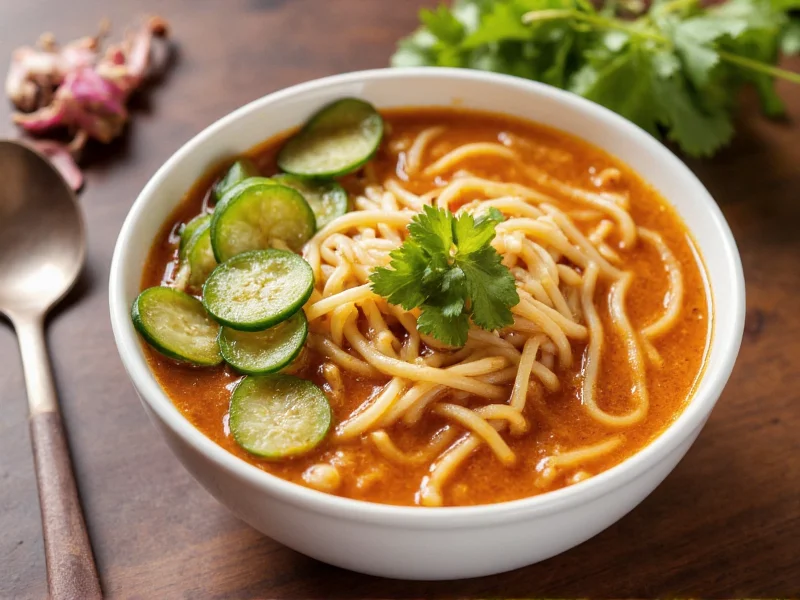Vegan noodle soup has become a staple in plant-based diets worldwide, offering both comfort and nutrition in a single bowl. Unlike traditional versions, vegan adaptations maintain rich umami flavors while eliminating all animal products. The secret lies in strategic ingredient selection and proper layering of flavors that mimic traditional bone broths without compromising ethical or dietary requirements.
Essential Components of Authentic Vegan Noodle Soup
Creating a satisfying vegan noodle soup requires understanding three critical elements: broth depth, protein balance, and vegetable integration. Many beginners make the mistake of using plain vegetable broth, which lacks the complex umami profile essential for authentic noodle soup experiences.
The foundation of exceptional vegan noodle soup starts with a deeply flavored broth. Professional chefs achieve this by simmering dried shiitake mushrooms, kombu seaweed, and roasted onions for at least 45 minutes. This creates a rich, savory base that serves as the perfect easy vegan noodle soup recipe foundation for beginners. Adding a splash of tamari or liquid aminos in the final minutes enhances the umami without overpowering other flavors.
Protein Sources for Satisfying Vegan Noodle Soup
Protein balance makes or breaks a healthy vegan noodle soup. Unlike meat-based versions, vegan adaptations require thoughtful protein pairing to ensure complete amino acid profiles. The most effective combinations include:
| Protein Source | Preparation Method | Protein per Serving | Best Pairings |
|---|---|---|---|
| Firm Tofu | Pressed, cubed, pan-fried | 10g | Miso broth, bok choy |
| Tempeh | Steamed, marinated, baked | 15g | Peanut broth, spinach |
| Edamame | Shelled, lightly boiled | 8g | Coconut curry broth |
| Lentils | Pre-cooked, added late | 9g | Miso-tahini broth |
For those seeking a quick vegan noodle soup for beginners, pre-baked tofu cubes offer the simplest solution. Simply add them during the last five minutes of cooking to maintain texture. More experienced cooks might prefer marinating and baking their own tofu for superior flavor absorption.
Regional Vegan Noodle Soup Variations
Vegan adaptations of traditional noodle soups maintain cultural authenticity while respecting plant-based diets. Each region's signature dish requires specific modifications to preserve authentic flavor profiles:
- Vegan Ramen: Replace pork broth with kombu-shiitake dashi, use vegan ramen noodles (check ingredients), and top with marinated mushrooms instead of chashu pork
- Vegan Pho: Simmer star anise, cinnamon, and charred ginger with mushroom broth; use rice noodles and top with tofu instead of beef
- Vegan Udon: Create dashi from dried shiitakes; use thick wheat udon noodles with tempura bits and green onions
- Vegan Laksa: Blend coconut milk with lemongrass and galangal; use rice noodles with tofu puffs and bean sprouts
These adaptations demonstrate how a traditional vegan pho recipe maintains the essence of the original while meeting dietary requirements. The key is understanding which elements contribute most to the dish's signature flavor and finding appropriate plant-based substitutes.
Nutritional Benefits of Well-Formulated Vegan Noodle Soup
A properly constructed vegan noodle soup delivers impressive nutritional value. When formulated with attention to complete nutrition, a single serving provides:
- 15-20 grams of complete protein through strategic ingredient pairing
- 30-40% of daily vitamin C from vegetables like bok choy and carrots
- 25-35% of daily iron from ingredients like spinach and tofu
- Significant fiber content from vegetables and whole grain noodles
- Naturally low saturated fat content (typically under 2 grams per serving)
This makes vegan noodle soup an excellent choice for vegan noodle soup meal prep, as it maintains quality when stored properly. The broth actually improves in flavor after 24 hours as ingredients continue to meld.
Avoiding Common Vegan Noodle Soup Mistakes
Even experienced cooks make critical errors when preparing protein-rich vegan noodle soup. The most frequent mistakes include:
- Overcooking vegetables - Add delicate greens during the last 2 minutes
- Using low-quality broth - Invest time in proper broth preparation
- Incorrect noodle timing - Cook noodles separately to prevent mushiness
- Skipping acid elements - Finish with rice vinegar or lime juice
- Overcrowding the bowl - Maintain proper broth-to-solid ratio (60:40)
For those following gluten-free diets, a gluten-free vegan noodle soup requires special attention to noodle selection. Rice noodles work well but need precise cooking times - typically 2-3 minutes in boiling water. Always rinse immediately in cold water to stop cooking and prevent sticking.
Storage and Reheating Guidelines
Proper storage techniques ensure your vegan noodle soup maintains quality. Follow these professional recommendations:
- Store broth and solids separately for maximum freshness
- Consume within 4 days when refrigerated in airtight containers
- Freeze broth for up to 3 months; add fresh noodles when reheating
- Reheat gently over medium-low heat to preserve texture
- Refresh flavors with additional tamari or lime juice after reheating
These practices make vegan noodle soup ideal for weekly meal preparation. When stored correctly, it provides a nutritious vegan noodle soup option that requires minimal daily preparation.











 浙公网安备
33010002000092号
浙公网安备
33010002000092号 浙B2-20120091-4
浙B2-20120091-4